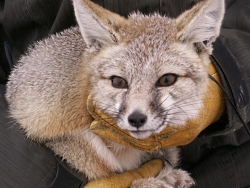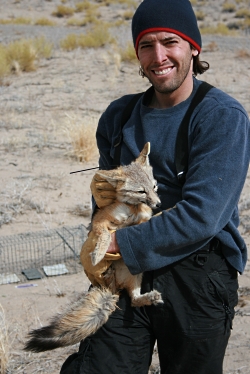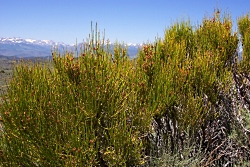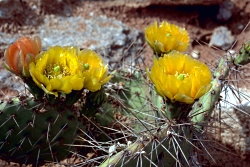
captured with a box trap.
Kit foxes are weighed,
fitted with a radio collar,
and then released
Courtesy & Copyright © 2010
Bryan Kluever
Graduate Research Assistant
Utah State University
Dept of Wildland Resources
 Adult kit fox prior to being
Adult kit fox prior to being
released. Note the black
collar antenna on the right
side of the fox.
Courtesy & Copyright © 2010
Bryan KlueverOne of the first things observers notice about the kit fox is its tiny size. Weighing in at a mere four pounds or so, Vulpes macrotis is among the smallest canids on the planet.
Often mistaken for swift foxes, kit foxes are a distinct species that sport larger ears and a leaner, more angular appearance. The small mammal has a long, black-tipped bushy tail and a yellowish-gray coat tinged with rusty orange.
Listed as a sensitive species in Utah, the carnivores live primarily in the state’s arid, western regions, where they reside in family dens and hunt for smaller mammals such as field mice and jackrabbits, as well as insects, birds, amphibians and fish.
But the diminutive hunter is susceptible to predation by a host of larger beasts, including coyotes, bobcats and golden eagles, says USU alum and wildlife biologist Bryan Kluever.
“With small size comes disadvantages; however, the advantage is increased agility and mobility,” he says.
Kit foxes have little difficulty leaping over sagebrush and rabbitbrush that towers over them and provides a welcome refuge from hungry predators. Given a choice, the foxes prefer to stay in open areas, where they can put their sense of sight to full use. Their vulnerability to larger members of the food chain partially explains the animal’s nocturnal habits.
“The life of a kit fox is ruled by the night,” Kluever says. “They are rarely active during the day and, when they are, this activity is limited to near dawn and dusk. This behavior is likely a function of eluding their enemies and avoiding harsh desert temperatures, especially in summer.”
One of the kit foxes’ most distinctive traits is its insatiable curiosity.
“If one word had to be used to describe the kit fox, it would be inquisitive,” says Kluever, who extensively studied the creatures at the Army’s Dugway Proving Ground. “Most canids cannot be captured with cage traps but kit foxes are one of the exceptions. When we released them after capture, they often began to walk toward us, rather than running away.”
Thanks to USU’s Quinney College of Natural Resources for supporting research and development of this Wild About Utah topic.
Credits:
Theme: Courtesy & Copyright Don Anderson Leaping Lulu
Images: Courtesy & Copyright Bryan Kluever
Text & Voice: Mary-Ann Muffoletto, Utah State University College of Natural Resources
Credits:
Bryan Kluever, wildlife biologist, Fort Carson Military Installation, Colorado.
Additional Reading:
Utah’s Desert Fox, Mary-Ann Muffoletto, Wild About Utah, May 27, 2010, https://wildaboututah.org/utahs-desert-fox/
White, P. J. and K. Ralls. 1993. Reproduction and spacing patterns of kit foxes relative to changing prey availability. Journal of Wildlife Management 57:861–867 The Wildlife Society, https://si-pddr.si.edu/dspace/bitstream/10088/510/1/White1993.pdf
Kit Fox (Vulpes macrotis), Species, Utah Division of Wildlife Resources, Utah Department of Natural Resources, https://fieldguide.wildlife.utah.gov/?species=vulpes%20macrotis







